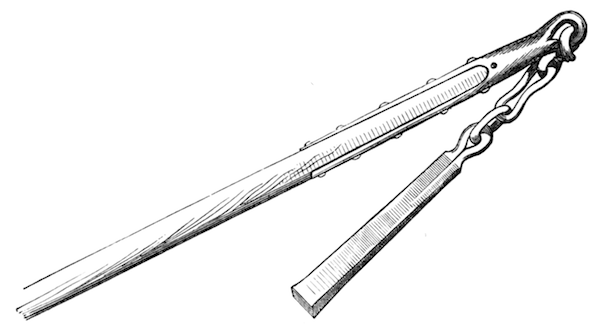Many systems for nuancing weapons function as an overlay for simpler base rules. Maces might gain benefits versus armored opponents, for example. This is a good approach as it is easy to understand and has reasonable face validity, but leads to problems of needing to come up with benefits for weapons that do not easily suggest advantages, such as the basic arming sword. This becomes especially clear when using d6 damage for all weapons. It is, in some sense, the inverse of the problem with AD&D variable damage. When the longsword does d8/d10 damage and maces deal d6, damage dealing capacity dominates. When all weapons deal flat damage, extra properties dominate.
In order to navigate these twin rules design hazards, here is an experiment that trades damage dealing potential for benefits, but uses a drop highest/lowest dice scheme to keep the expected damage bounded (no comments about 5E please; Philotomy did it first). Further, the effect of benefits is increased, because they need to really be clearly better within a given niche. A mace getting +1 or +2 to hit versus armor is just not good enough to justify the decreased effectiveness against all other types of opponents.
This is a mechanics-first approach to balancing weapon capabilities and power. Rather than looking at weapons naturalistically and applying special-case rules as necessary to represent weapon benefits, this guarantees a level of mathematical trade-off. It is meant to coexist with d6 hit dice as well, but could also be applied to a variable hit die (“Basic style”) approach, substituting class hit die for the d6. Rules have been phrased here in terms of the d6, however, for clarity.
Weapons begin with one of the following templates:
- One-handed melee: 1d6 damage
- Two-handed melee: 2d6 (take best) damage
- Two-handed missile: 1d6 damage
Then, properties (benefits and flaws) may be applied by moving up or down the damage dice chain. Rolling multiple dice means the best (or worst) value is taken, depending on where in the dice chain the weapon lies. For example, a one-handed melee weapon with a benefit drops down to two dice, take lowest. Add another benefit and it would be doing three dice, take lowest. And so forth. Flaws may be added to move up the dice chain. For example, a one-handed long-haft (flaw) reach (benefit) spear does one die of damage (standard one-handed melee template) and the reach/awkward properties balance out. In essence, lower damage is a flaw and higher damage is a benefit.
This means that you could have a one-handed melee throwable, armor-piercing, sundering weapon, but you will be rolling 4d6 and taking the worst result for damage when using this swiss army knife monstrosity (assuming it has no flaws). There are some interesting corollaries from this system which you do not often see, such as the 3d6, take best two-handed long-haft pole-arm (meaning that it can only be used effectively with two hands and at reach, which seems just right).
Benefits
- Armor-piercing: +4 attack versus medium or heavy armor
- Close: +4 attack following grapple
- Reach: attack from the second rank
- Sundering: +4 when trying to damage armor or shields
- Throwable
Weapons acting within their area of specialty (for example, reach weapons at reach or armor-piercing weapons versus armor) never deal less than one die of damage.
(Rather than the +4 bonus, you could also use 5E style advantage.)
Flaws
- Crude: drops down one damage die step per level of target armor
- Dangerous: wielder takes 1d3 damage on natural 1 attack rolls
- Heavy: following a miss, an action is required to ready the weapon
- Long-haft: may only be used at reach
- Slow: requires an action to ready (or reload)
If using an approach like this, a set of basic weapons should probably be defined so that players don’t need to do any reasoning to figure out how a mace should be represented. There is no reason not to expose the underlying system for players that wish to “build” slightly more unique weapons as well though. The list of properties was kept intentionally short, based on my experience with weapon property systems, and should be taken as a set of examples rather than a comprehensive list. New properties giving bonuses to particular maneuvers (such as a bonus to disarm maneuvers for a weapon like a parrying dagger) could be added as needed, keeping in mind basic balance considerations.
A few weapons do not fit well into this structure, such as nets and whips. This seems less like a flaw in the system, though, than a sign that such items are not really weapons (that is, tools designed to deal damage), but rather things with more specific purpose that just happen to be useful in combat. It is probably better to give such items special moves that can be made in combat and design them outside of the strictures of these guidelines.

Public domain image from Telecanter

Pingback: Build your own weapons for D&D | OSR Today
i like this a lot. you’re never dealing more than 6 damage, is that right?
@Mott
Yeah, that’s right. Never more than 6 damage.